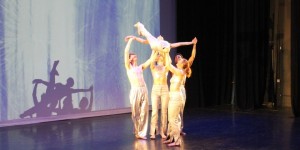AUDIENCE REVIEW: Botis Seva’s Far From The Norm In “BLKDOG”

Company:
Far From The Norm
Performance Date:
October 9
Freeform Review:
We hear sounds of a man, winded, out of breath, running down a hallway. A child asks their parents to read a bedtime story, dinner plates bang onto a table, a locker closes and echoes. As light envelopes the stage, we notice one dancer sitting, legs-crossed, facing away from us. His torso sways quickly from side to side, his arms splay out then recoil back to him. A gunshot sounds, and the dancer collapses.
On October 9, 2024, Botis Ceva opened at The Joyce Theater with his company Far From The Norm. This Joyce presentation of “BLKDOG”, an Olivier Award Winning production, marks the choreographer’s U.S. premiere. Ceva, who formed his company at age 19 specifically to push the boundaries of Hip Hop, here uses a robust mix of Hip Hop and physical theater as a mechanism for storytelling. He brings the audience into a dark world, and asks us to reflect on both violence and the lasting effects of trauma.
From the onset Ceva’s company is anonymous, dressed head-to-toe in gray sweats, with matching gray head coverings, it is challenging to distinguish one dancer from the next. All individuality is lost. They could be one person or they could represent every person, or perhaps by the loss of individuality, Ceva is reminding us of how easy it is to overlook violence when we think of it happening to others, those without a name or recognizable face.
Rapid pungent gestures punctuated by moments of pause, acknowledge a deep sense of panic. These are bodies grappling for survival. Their sharpness and fast pace alludes to the speed with which brutality can strike. Their pauses allow only a moment for them (and the audience) to catch their breath. Violence never truly leaves, it is etched into the body.
Throughout the work, we hear a disembodied voice repeating: "Maybe you should start with how you are feeling.” This phrase occurs in conjunction with specific, disquieting gestures performed in a loop: a continuous bobbing head, arms held out to the side with frantic hands waving, fingers pointing. With constant repetition, the beginning and ends of movement blur. Yet, amidst a wounded environment, a certain hope emerges. During the repetitions of phrases one dancer always remains seated—a hint of the individual's power to go against the norm. Tiny moments of resistance, small efforts to break free from a pattern, convey a sense of aspiration, a manifestation that the cycle of trauma can, and should, be broken. The disembodied voice says, "Give the people what they want,” as the dancers remove their shirts and swing them in the air, swaying their hips and shifting into freestyle, popping and locking.
Is this hopeful or does giving “the people” what they want mean that we, the people, would rather be blind to violence and entertained? As “BLKDOG” concludes, the dancers remove their head coverings. We see their entire face and head for the first time. "Just like her. Just like him. Just like me. Just like God,” says the voice. Ceva reminds us we are all in this world together. As the cast holds their head coverings, gazing softly into the audience, their eyes hold hope but the rest of their expressions demonstrate concern. “BLKDOG” implores us to see our brothers and sisters and manifest a humanity rooted in healing.
Author:
Rachel Marchica
Photo Credit:
Camilla Greenwell














